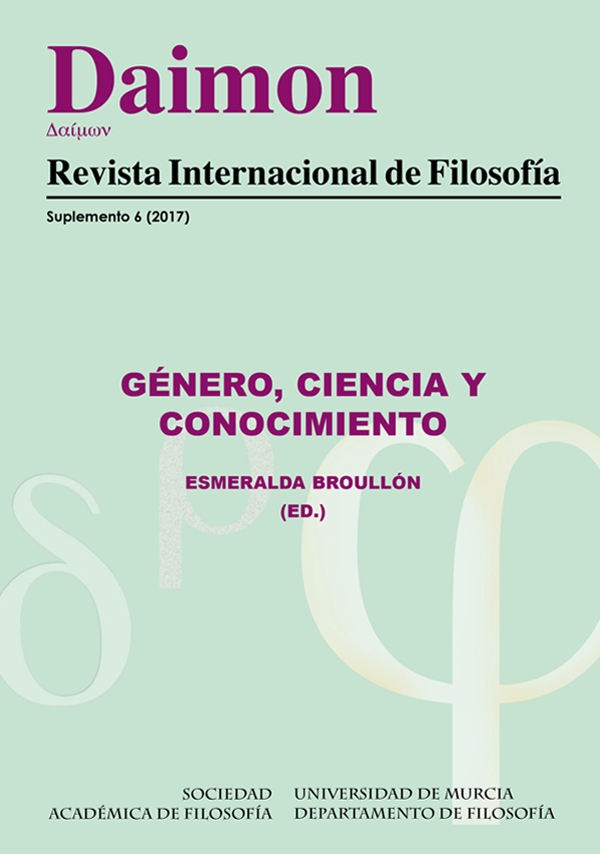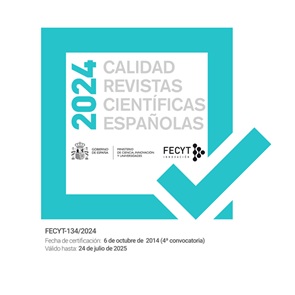Tecnorituales del embarazo: Cuerpos de mujer en el origen de la genética medica
Resumen
El objetivo de este artículo es mostrar la participación de las mujeres y de su descendencia en la construcción de la genética médica. Las mujeres y la infancia han sido el foco de atención de la genética desde que este espacio biomédico apareció en la clínica entre finales de la década de 1950 y principio de la de los 1960. Esto fue así porque la agenda de la fertilidad ha guiado en buena parte los estudios y los razonamientos sobre la herencia de caracteres en la genética médica, después. Para desarrollar esta idea presentaré una historia de las imágenes de la genética durante ese periodo, narrativas visuales que transitan de los cuerpos humanos a las imágenes de sus cromosomas, para regresar a los cuerpos, e incluir a la genética medica y sus diagnósticos entre los derechos que la cultura de la reproducción han concedido a las mujeres, entre ellos el del denominado aborto terapéutico en la era de la prensa fetal gráfica y la ecografía obstétrica.
Descargas
-
Resumen563
-
PDF365
Citas
Akrich, M. y Pasveer, B. (1996), Comment la naissance vient aux femmes: les techniques de l'accouchement en France et aux Pays-Bas, Paris: Synthélabo.
Clarke, A., L. Mamo, J. R. Fosket, J. R. Fishman, and J. K. Shim (2003), “Biomedicalization: Technoscience, Health, and Illness in the US,” Annual Review of Sociology 18, pp. 209–32.
del Cura González, Mercedes (2011), Medicina y pedagogía: la construcción de la categoría infancia anormal en España: 1900-1939, Madrid: CSIC.
del Cura, M. (2016), “La subnormalidad a debate: discursos y prácticas sobre la discapacidad intelectual en el segundo franquismo”, História, Ciências, Saúde-Manguinhos, 23, pp. 1041-1057.
Duden, B. (1993), Disembodying women: Perspectives on pregnancy and the unborn, Cambridge, Harvard University Press.
Duden, B. (1991), The Woman Beneath the Skin: A Doctor’s Patients in Eighteenth-
Century Germany, Cambridge, MA: Harvard University Press.
Gaudillière, J.-P. (2001), ‘Bettering Babies: Down’s Syndrome, Heredity and Public Health in Post-war France and Britain’, en I. Löwy y J. Krige (eds.) Images of Disease. Science, Public Policy and Health in Post-war Europe, Luxemburgo, Office for Official Publications of the European Comunities.
Gauthier, M. (2009), ‘Cinquentenaire de la trisomie 21. Retour sr une decouverte’, Medicine/Sciences 9 25, 31-316.
Ha, Nathan Q. (2011): “The Riddle of Sex: Biological Theories of Sexual Difference in the Early Twentieth-Century”, Journal of the History of Biology 44: 505–546.
Hogan, A. (2016), Life Histories of Genetic Disease, Baltimore: Johns Hopkins University Press.
Jiménez Díaz, C. (1965), La historia de mi instituto, Madrid: Paz Montalvo.
Keating, P. and Cambrosio, A. (2003), Biomedical platforms: realigning the normal and the pathological in late-twentieth-century medicine, Cambridge, MA, MIT Press.
Kevles, D. J. (1985). In the name of eugenics: Genetics and the uses of human heredity (No. 95), Cambridge, MA: Harvard University Press.
Kottler, M. J. (1974), “From 48 to 46: Cytological technique, preconception, and the counting of human chromosomes”, Bulletin of the History of Medicine, 48, pp. 465.
Lautre, M. J. (1976), “Predicción antenatal de las anomal.as cromos.micas”, en: J. Botella and L. Izquierdo (eds.), Problemas actuales de genética humana, Madrid: Instituto de España, pp.177–91.
Laxova, R. (1998), “Lionel Sharples Penrose, 1898-1972: A personal memoir in celebration of the centenary of his birth”, Genetics, 150, pp. 1333-1340.
Lejeune, J., Gauthier, M., Turpin, R. (1959), “Study of somatic chromosomes from 9 mongoloid children”, Comptes rendus hebdomadaires des seances de l'Academie des sciences, 248, pp. 1721-22.
Lindee, M. S, (2005), Moments of truth in genetic medicine, Baltimore: John Hopkins University Press.
Lippman, A. (1991), “Prenatal Genetic Testing and Screening: Constructing
Needs and Reinforcing Inequalities”, American Journal of Law and Medicine, 17, pp. 15–50.
López Beltran, C. (2004), El sesgo hereditario: ámbitos históricos del concepto de herencia biológica, Ciudad de México: Universidad Nacional Autónoma de México.
López Beltran, C. (2007) “Hippocratic bodies. Temperament and Castas in Spanish
America (1570–1820)”, Journal of Spanish Cultural Studies, 8, pp. 253–89.
Martin, A. (2004), “Can’t any body count? Counting as an epistemic theme in the history of human chromosomes”, Social Studies of Science, 34, pp. 923-948.
Martin, A., y Lynch, M. (2009), “Counting things and people: The practices and politics of counting”, Social Problems, 56, pp. 243-266.
Miller, Fiona A. (2006): “‘Your true and proper gender’: the Barr body as a good enough science of sex”, Studies in History and Philosophy of Biological and Biomedical Sciences, 37, pp. 459-483.
Morgan, L. M. (2004), “A social biography of Carnegie embryo no. 836”, The New Anatomist, 276, pp. 3-7.
Nash, M. (1996), “Pronatalismo y maternidad en la España franquista, en: G. Bock y P. Thane (eds.), Maternidad y políticas de género, Madrid, Cátedra-Instituto de la Mujer, pp. 279-307
Nilsson, Lennart, Axel Ingelman-Sundberg, and Claes Wirsén, Ett barn blir till: (Stockholm: Bonnier, 1965). Versión cast, Un niño va a nacer: el primer drama de la vida. Barcelona: Doyma 1967, trad. cast. J. Masoliver.
Nowell, P., J. Rowley, and A. Knudson (1998), “Cancer Genetics, Cytogenetics—Defining the Enemy Within”, Nature Medicine, 4, pp. 1107–11.
Ortiz-Gómez, T. e Ignaciuk, A. (2018), The fight for family planning in Spain during late Francoism and the transition to democracy, 1965-1979, Journal of Women’s History, (en prensa).
Parache Hernández, Javier y Martínez Hernández, H. (1970), Diagnóstico mediante ecografía bidimensional en obstetricia y ginecología, Acta Ginecológica XXI: 727-765.
Parache, J., L. Izquierdo, P. Fernández, M. J. Lautre (1973), “Cultivo de líquido amnióticos. Detección de anomalías genéticas, Acta Ginecológica, 24, pp. 389-396.
Park, K. (2006), Secrets of women: gender, generation, and the origins of human dissection, New York: Zone books.
Penrose, Lionel S., The biology of mental defect (London: Sidwick and Jackson, 1949)
Sánchez Cáscos, A., Morales, A. y Barreiro, E. (1964), “Estudio genético de veinte casos de síndrome de Down (mongolismo)”, Revista Clínica Española, XCIII, pp. 23-
Santesmases, M. J. (2008), “Hacia descendencias saludables: algunos orígenes del diagnóstico prenatal en España”, Asclepio, 60, pp. 129-150.
Santesmases, M. J. (2014a), “Superfemale: cromosomas humanos y representaciones del sexo”, en: E. Pérez Sedeño y E. Ortega Arjonilla, eds., Cartografías del cuerpo. Biopolíticas de la ciencia y la tecnología, Madrid, Cátedra, pp. 393-422.
Santesmases, M. J. (2014b), “The autonomous karyotype and the origins of prenatal testing: Children, pregnant women and early Down’s syndrome cytogenetics, Madrid 1962-1975”, Studies in History and Philosophy of Biological and Biomedical Sciences, 47, pp. 142-153.
Santesmases, M. J. (2017), “Circulating biomedical images: Bodies and chromosomes in the post-eugenic era”, History of Science, doi: 0073275317701145.
Scanlon, G. (1986), La polémica feminista en la España contemporánea, 1868-1974, Madrid: Akal.
Las obras que se publican en esta revista están sujetas a los siguientes términos:
1. El Servicio de Publicaciones de la Universidad de Murcia (la editorial) conserva los derechos patrimoniales (copyright) de las obras publicadas, y favorece y permite la reutilización de las mismas bajo la licencia de uso indicada en el punto 2.
2. Las obras se publican en la edición electrónica de la revista bajo una licencia Creative Commons Reconocimiento-NoComercial-SinObraDerivada 3.0 España (texto legal). Se pueden copiar, usar, difundir, transmitir y exponer públicamente, siempre que: i) se cite la autoría y la fuente original de su publicación (revista, editorial y URL de la obra); ii) no se usen para fines comerciales; iii) si remezcla, transforma o crea a partir del material, no podrá distribuir el material modificado.
3. Condiciones de auto-archivo. Se permite y se anima a los autores a difundir electrónicamente las versiones pre-print (versión antes de ser evaluada) y/o post-print (versión evaluada y aceptada para su publicación) de sus obras antes de su publicación, ya que favorece su circulación y difusión más temprana y con ello un posible aumento en su citación y alcance entre la comunidad académica. Color RoMEO: verde.











